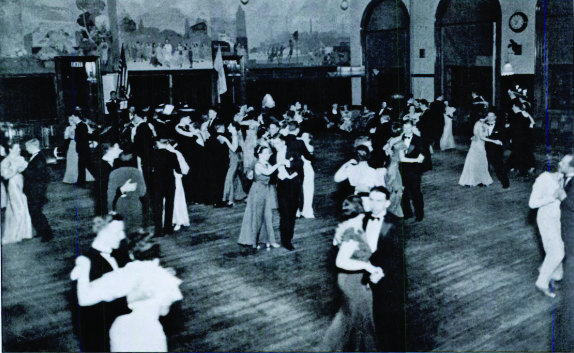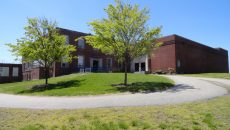(Courtesy of Dr. Marie Frank) The murals were noticed in the background of class of photos and event photos.
Brigid Archibald
Connector Editor
It is hard to believe that historical paintings could ever just be forgotten, but that is precisely what happened in Coburn Hall.
The paintings, located on the second floor in the assembly room, were a part of the Works project era, a precursor to the Works Progress Administration (WPA) from the New Deal. Dr. Marie Frank, an art history professor at UMass Lowell who discovered the paintings, speculates that they were probably painted over in the ‘70s or ‘80s during the room’s time housing library stacks or during its time as offices.
As part of Coburn’s renovation, the assembly room where the murals are housed will be turned into three separate rooms including two meeting rooms and open study space. The rooms have been designed with glass walls to ensure that the view of the murals will not be obscured despite this.
Adam Baccke, the Director of Campus Faculties and the Co-chair or the universities Art and Artifact committee, explained that as UMass Lowell strives to become a world-class multi-dimensional university, it tries to incorporate art and artifacts into the daily life of students and faculty. When the university begun to plan the Coburn’s renovation, they felt there would be no better way to do that in a historical building like Coburn than with the historical arts like these paintings.
The mural is split into three parts, telling the story of Lowell, Dr. Frank explained to the Connector. The middle panel was meant to depict the educational impulse of the city showcasing the original schools of Lowell such as the Coburn Mission school, the Dracut academy and the Mammoth Road school. Above this are icons that represent the people of Lowell’s countries of origin. The right Panel shows the culture of the city– people are dancing, painting and playing sports– on a backdrop of Lowell’s skyline. Major structures such as City Hall’s clock tower are easy to identify. The left Panel is dedicated to the arts and sciences and depicts people painting and crafting. In the background are examples of famous architecture.
“It’s about all the people coming to Lowell and having access to an education. That’s their message, their history, and that’s our history and our message now today,” said Dr. Frank on why the murals fit so well into the narrative of UMass Lowell.
Dr. Frank had discovered the paintings back in 2012 when she was doing research on her book the University of Massachusetts Lowell which covers the history UMass Lowell’s campus. During her research she noticed the paintings in the background of photos taken in Coburn.
With no record of these paintings at the school, she and a graduate student scoured local newspapers for a clue as to what they were. Sure enough, they discovered that during the Great Depression the city of Lowell had been selected to take part in a project with the goal of revitalizing the economy by employing more artist. These paintings and other projects around the city were a part of this effort.
It is a stroke of luck that the paintings are recoverable despite the oil-based paint that was used as a top coat. The top coat had presented concerns because the murals are also oil based and oils in paints tend to mix together making it impossible to remove the top coat without destroying what lays beneath. However, in a stroke of luck to whoever painted over the mural’s years ago forgot to wipe down the walls, leaving a layer of charcoal dust from the building’s heaters. The soot prevented the oils from blending and protected the paintings for the last 40 to 50 years.
However, the murals did not make it through all that time completely unscathed. The artwork had been so completely forgotten that in 2012, just as Dr. Frank herself was starting to become aware of the murals, a digital projector was installed in the middle of where the murals should have been.
Fortunately, that is the only damage that the wall has sustained, and it will be repaired as the Conservator Gianfranco Pocobene begins his work sometime in the late spring or early summer. Since Pocobene must use toxic cleaning materials, the room needs to be adequately ventilated and the entire building must remain closed. Baccke explained that as this process begins a live cam will be placed in the room showing a time-lapse of the restoration process.




